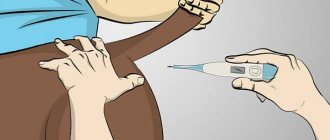Behavior before impending birth
Gestation in dogs is about 63 days.
Throughout pregnancy, the behavior of most dogs remains unchanged. Changes in behavior begin to appear in the last week. The main change is the desire to arrange a “nest”. The animal lies down on the floor, begins to scratch it, and turns over the bedding. Some dogs build a “nest” on the street, but do not hide from humans. Animals begin to hide tidbits that previously would have been eaten immediately. They become distrustful and irritable. They show aggression even towards people they know well and limit their social circle. They strive to defend their territory. They become emotionally unstable, so during this period it is advisable to exclude their communication with children. Some dogs begin to show interest in soft toys that look like small puppies. They react to the squeaking and crying of small children.
Significant changes in the behavior of dogs occur immediately before birth - within a day or two. First of all, before giving birth, a dog almost never remains in its usual place, which reveals atavistic properties inherited from the wolf. In addition, this is due to the division of the habitat into zones - a place for eating, a place for whelping, and a “nest”.
As the time of birth approaches, the dog begins to show anxiety. She constantly gets up from her bed, walks back and forth, lies down, gets up again, asks to go outside. The dog is nervous, worried, looking under its tail. Changes his location all the time. During contractions, the dog's muzzle takes on a rather unusual expression: the dog's gaze is motionless and concentrated on a nearby object. The tail is held in a peculiar way: individuals with a straight and long tail stretch it straight back, and the tip hangs down in some unusual way.
If signs of imminent birth appear, the animal must be placed in the place where the birth will take place and not be left alone.
Signs of impending birth in dogs
- Before giving birth, she will be nervous and make a “nest”
- the dog will try to stay close to people, will not go anywhere from the person, she will want to be petted, and then she will leave for 1-2 days, give birth, and then return!
- After the appearance of milk, the period is approximately 5 hours to 2 days. That's when he starts running, look for a place and wait in the next two to three hours.
- A normal pregnancy in dogs lasts 58-70 days, depending on the number of puppies. The more puppies in the womb, the shorter the period. You need to count 58 days from the first day of mating and start measuring TEMPERATURE (thermometer in the butt for 5 minutes, the norm is from 38 to 39 degrees). First, we measure every 4-5 hours, the next day, every 3-4 hours, then every 2 hours and RECORDING!! ! As soon as the temperature starts to drop, some bitches reach 37.5, others up to 37... and stop.... That means puppies are on the way. The stomach should drop and the dog begins to wander around the apartment looking for a place. Digging, laying down.. You need to prepare - a lot of clean rags to wipe the puppies, scissors, boric alcohol, brilliant green, symptomicin emulsion. No-shpu, oxytocin, sulphocamphocaine (cardiac), calcium gluconate - VS IN AMPOULES, . A basin or box with warm bedding, a table lamp - to warm the puppies. When the bitch's temperature is 37 degrees. starts to rise, then birth is expected around 6-12 hours. The bitch will breathe heavily - with an open mouth, and may begin to shake, as if in a chill, and as soon as she begins to push and a wave goes through her stomach, labor has begun. Make a place for her in a corner, lay some newspapers, there will be a lot of dirt, don’t fuss with the whole family, let only one deliver the baby, the rest shouldn’t interfere. Puppies are born in the amniotic sac and with an afterbirth. The dog will try to eat them, do not give more than 1-2, otherwise there will be severe diarrhea. Break the bubble carefully, use alcohol-treated hands and scissors to cut the umbilical cord 5-6 cm from the tummy and spread it thickly with brilliant green. Place the puppy next to the mother and let it suck, put the nipple in your mouth and press down so that the milk comes out. But during contractions, the puppies are put in a box. IF YOU HAVE ANY QUESTIONS, write to me by email.
- The temperature drops to 37 a day before birth.
The dog begins to build a nest. Sometimes she becomes restless and irritated, or, on the contrary, revolves around you. Shortness of breath appears (reaction to contractions). It seems that a day before the birth the mucus plug is still released... I don’t know exactly, I can only wish you good luck) ) PS: We ourselves are waiting for replenishment. - A day before giving birth, the temperature will drop by one degree, the dog will begin to breathe, as if it had run many kilometers. without stopping (the contractions haven’t started). This breathing, which frightens many inexperienced owners, will continue for about one day. Pregnancy in a female dog lasts an average of 62-64 (57-66) days.
- My temperature stayed at 37.5 for a day, it’s already been 37 for two days and I don’t plan to give birth. ..
- My dog has already given birth 2 times, now we have moved, she does not want to give birth in the house, she stubbornly asks to go to the garden. I don’t let her there, it’s cold and the wind is strong. Problem. I hope she gives birth where I prepared for her
- Many people wrote to you well, well, I’ll add 7-0 days before birth - milk appears (in first-time mothers it is always later) in 2 days - the loop swells greatly in 1 day - the level of progesterone in the blood decreases in 1 day - the mucous plug comes out in 24 hours - lowered by that. up to 37c in 6-12 hours - preparatory phase: nervousness, tearing of one's bedding, heavy breathing, contractions.
- Our dog has a temperature of 37.5, but it doesn’t look like she’s going to give birth.
- My dogs (of different breeds) refused to eat before giving birth; within 12 hours they went into labor, sometimes they ate, but they immediately vomited. And also, if a dog gives birth for the first time, during the pushing, the dog often asks to go outside, to be taken once, but with a diaper (so that, if anything happens, he can accept the puppy on the street), and then to be taken to the maternity area. Sometimes the dog doesn’t like the birthing place, let him go where he likes (only so that he has access to the puppy), then take the puppy and put him in the right place, and the rest will give birth where necessary. And the dog’s attempts can be seen as a wave going through the body from the head to the tail (not to be confused with contractions, they are manifested by small tremors, but after the contraction there may be attempts immediately).
- Mine eats all the time... even during childbirth)))
- Usually dogs whelp on 62-64 days after mating, look at the calendar if you know the day of mating. But in fact, all dogs behave differently, for example, my Rottweiler, when it was time to whelp, simply went into another room, and the Caucasian Shepherd literally did not jump on the walls! Yes, even when the bitch begins to produce milk, it can be a so-called false pregnancy. talk to her more often and don’t let her go, if this is your first experience, then it’s better to call a veterinarian for a while!
Dog behavior before giving birth
A change in your dog's behavior will tell you that your dog's due date is approaching. She begins to behave restlessly, digs, and does not stay in one place for long. Sometimes a bitch tends to hide in a dark place. It happens that, on the contrary, she is always next to her owner, as if asking for help. Sometimes a pregnant dog may refuse to eat before giving birth or, on the contrary, eat a lot. During this time, your dog needs special attention and care.
Signs of childbirth in a dog are a downward displacement of the abdomen, immobility of the puppies inside, and a drop in the animal’s body temperature to 37 degrees. Even when contractions are just beginning, the dog already feels pain. A day before giving birth, she notices specific discharge. They can be grayish or white, quite thick and sticky. The bitch's heart rate and breathing become rapid.
Possible causes of increased temperature
On women's forums, women very often ask about what to do if the temperature at 38-39 weeks of pregnancy rises above 37 degrees. It should be noted that such an increase in body temperature occurs quite often, and you should not worry too much about it. But such a symptom cannot be neglected. Sometimes a temperature rise just above 37 degrees can signal the onset of a serious illness. An increase in temperature by 0.5-1 degrees on the eve of childbirth is typical for 15-20% of pregnant women. And there may be several reasons for such an increase.
Firstly, an increase in temperature before childbirth can be caused by the use of anesthetics. Their period of action is about 6 hours with a possible effect on increasing the temperature of the pregnant woman. It should be emphasized that anesthesia, as a rule, does not provoke a high temperature.
Secondly, an increase in temperature caused by the presence of an infection in a woman’s body can be much more serious. A pregnant woman is more likely than ordinary people to “catch” an infectious disease, cold, or flu. Thirdly, expectant mothers may have various chronic diseases. For example, diseases of the genitourinary system, sinusitis.
Fourthly, the cause may be infections of the amniotic fluid or placenta. And the temperature just gives a sign of infection. This cause of fever can be the most dangerous, because infection inside the uterus poses a risk to the life of the child and mother. Infection through the blood can infect the fetus. In addition, such an infection can provoke premature birth. And a child born to an infected mother is susceptible to various diseases. For example, pneumonia, bacteremia, meningitis. That is why you need to be attentive to the rise in temperature during the prenatal period. If the diagnosis of the presence of infection in the uterus is confirmed, it is necessary to undergo a course of treatment, which includes antibiotics.
What is the normal temperature for large breed dogs?
- Large dogs have the lowest temperature compared to other breeds, whose metabolism is slower and their heart beats more evenly.
Temperature 37.4°C for adult large dogs and 38.2°C for puppies - this is the lower limit. 38.3°С and 39°С respectively .
- It should be remembered that, as for representatives of other breeds, minor deviations from the average are also possible for large dogs. In addition, it is representatives of large breeds that tolerate heat the worst, so in summer the temperature of dogs almost always rises.
By category
- It is advisable to measure the temperature of a large dog together, with an assistant holding it. It is better if the animal is muzzled or at least its mouth should be fixed.
Or maybe just stress?
Sometimes, on the eve of childbirth, women begin to worry very much. Excitement, stress, and nervousness before childbirth can cause an increase in body temperature. After all, under stress, even in a healthy body, chemical elements that provoke temperature begin to be produced. This reason is the most common explanation for elevated temperature. The body of the expectant mother thus signals that the baby will soon be born, that you will see him soon.
To avoid any complications and consequences, if your temperature rises, you should consult a doctor. Perhaps he will order tests to find the cause. Even if a child is born healthy, a latent and undetected maternal infection in his body may appear later.
An increase in a pregnant woman's body temperature above 37.5 degrees before childbirth is one of the grounds for visiting a doctor. Contacts and consultations, but no worries! The doctor will determine the reason, and whatever it is, the expectant mother should remain calm and be confident that everything will end well! And temperature is a temporary phenomenon, like other prenatal symptoms.
Pregnancy in a dog is a joyful and at the same time exciting event for the owner. An alarming signal may be an increase or decrease in the animal's temperature. What is the norm for a pregnant bitch, and why you should see a doctor, we will tell you in our article.
Normal body temperature for a pregnant dog
Just like in humans, an increase or decrease in body heat in dogs most often indicates some kind of disease or disorder in the body.
Temperature may rise for a short period in hot weather, after intense physical exertion, stress (visiting a doctor). However, in this case, she quickly returns to normal.
In the case of prolonged hyperthermia in dogs, you need to pay close attention to this, because this can be a signal of serious diseases - distemper, piroplasmosis, endometritis, allergies, abscess, inflammation of the joints.
A decrease is observed with helminthic infestation, parvovirus enteritis in puppies, and also before childbirth in bitches. We will dwell on the latter reason in more detail in the following sections.
It is believed that the temperature should be measured regularly in puppies, and in adults if the dog is sick or pregnant, before and after childbirth. In other cases, this can be done as needed.
IMPORTANT! For hygiene reasons, you should not use the same thermometer that is used to measure people's temperatures.
How to try on
Measurements must be made with a specially designed mercury or electronic thermometer for the animal.
The procedure is not complicated, however, it will require some skill from the owner. You need to reset the thermometer readings, lubricate its tip with Vaseline, put the dog on its side, calm it down and carefully insert it 1-2 cm into the animal’s anus.
It is possible to measure the dog's temperature while it is standing, but it will be more difficult for an inexperienced owner to do this. When using an electronic thermometer, you need to wait 1 minute, but if the thermometer is mercury, you will have to hold it for 3 to 5 minutes.
ATTENTION! It is very important to create a calm atmosphere for the dog from the first measurement and ensure that the procedure is painless. You can reward the animal with a treat. If the training for this procedure has been completed correctly, the dog will not be afraid or resist, and it and the owner will be comfortable measuring the temperature in the future.
Otherwise, the dog may begin to twitch and squirm, which is why the thermometer will probably break and injure the animal or person, not to mention the fact that the temperature will never be measured.
What is considered the norm? Thus, the following temperature indicators for puppies are accepted:
- small breeds – 38.6-39.3˚С
- medium breeds – 38.3-39.1˚С
- large breeds – 38.2-39.0˚С
and for adults:
- small breeds – 38.5-39.0˚С
- medium breeds – 37.5-39.0˚С
- large breeds – 37.4-38.3˚С
Pregnancy of bitches in itself should not introduce changes in the values of the measured temperature. Normally, it corresponds to the above standards depending on the size of the dog. However, it is possible that it may increase or decrease if any problems or illnesses arise. Only if the dog is pregnant and before giving birth, according to your calculations, approximately about a day, its sharp decrease is physiological.
How to measure a dog's temperature at home?
- You need to start by lubricating the thermometer. This could be cream, Vaseline, glycerin - anything that will help the device fit more easily.
- Having moved the dog's tail, carefully rotate the thermometer, inserting it into the animal's rectum not very deeply - 1-2 cm is enough.
Measurement
- Remember to speak kindly while taking your dog's temperature. If you are using an electronic thermometer, hold it until the beep sounds.
- Mercury should be held for up to 5 minutes, and with the help of infrared (it is used for the ears) you will know the result in the first seconds.
- After taking out the thermometer, wipe it with a cotton swab, after moistening it in any disinfectant.
Changes before childbirth
After mating a bitch, the owners eagerly await the first signs of pregnancy of their pet. On the 22nd day, it is already possible to carry out ultrasound diagnostics and make sure that it has occurred. On average, the duration of pregnancy in female dogs ranges from 57 to 69 days after fertilization.
Maintaining a schedule
Experts recommend prophylactically measuring the temperature of a pregnant bitch at least once a week, even if nothing is bothering you. Needless to say, if something bothers you in her behavior, you should immediately consult a doctor.
Attention! And when, according to the owners’ calculations, there is about a week left before the birth, in the morning and evening it is necessary to enter the measurement results into a graph or table in order not to miss the moment when it sharply drops by 1-2 degrees. It is believed that labor will occur within the next 24 hours.
This will allow the owner to prepare for the procedure and be freed from other matters in order to help the animal. Sometimes a doctor or a dog breeder experienced in this matter is immediately called to attend the birth.
Proper care for a pregnant dog
Hygienic measures for the animal include examinations every day, cleaning the fur, and checking the skin. In the second half of gestation, a pregnant dog sometimes has mucus discharge from the birth canal. In most cases, the dog removes the discharge by licking itself. In rare cases, when the dog is still young and this is her first pregnancy, she may not do this, then you should simply clean the area with ordinary clean water. However, there is no point in cleaning the animal 2 weeks before giving birth.
When the pet has not received timely treatment with deworming drugs before mating, in this case, this process must now be delayed for 14 days after the birth has been resolved. Remember that during the period of crossing dogs it is also necessary to abandon such activities and
An important harbinger of impending childbirth in bitches is a decrease in general body temperature
I was prompted to write this article by the skeptical attitude of many owners of breeding bitches and breeders towards one of the most important precursors of childbirth in dogs - a change in the general body temperature of the animal. At first glance, it may seem that a change in the body temperature of a pregnant bitch by 1 - 1.5 degrees, and even downward, means absolutely nothing for either the dog or its owner. But such an opinion, alas, is wrong. Due to my professional activity, I, unfortunately, had to deal with situations where the change in body temperature of a pregnant bitch was not taken into account by the owner of the animal. The result was intrauterine fetal death. It is extremely unpleasant and bitter to hear when breeders say that the veterinarian who monitors their animal claims that now, in our time, many bitches’ body temperature before giving birth does not change at all and remains constant. Interesting, isn't it? And how is this possible? For many centuries, all life processes in the body of bitches proceeded according to the physiological characteristics of mammals. Well, now, suddenly, out of nowhere, everything has changed dramatically. Is it really? Or, simply, someone hasn’t reviewed animal physiology, as well as veterinary obstetrics and gynecology for a long time?
I am sure that some new divorcees will probably ask a very pertinent question: “What are the harbingers of childbirth?” I’ll be happy to answer: “The harbingers of childbirth are changes that occur in the mother’s body at the end of pregnancy, by which one can judge the impending birth.” And these changes are usually taken into account in a comprehensive manner.
So what are these changes?
The first thing that noticeably changes in a pregnant bitch is her behavior. 24 - 36 hours before giving birth, the dog begins to carefully prepare the place for the birth of its puppies - to build a “nest”. She actively searches for the most secluded and darkest place. And in the presence of the owner, he often clings to his hands, looks questioningly into his eyes, and with all his behavior shows clearly expressed confusion and excitement.
The second visual change is the enlargement and swelling of the bitch's genital loop. The skin becomes smooth and even. The folds that existed on the loop disappear. When it comes into contact with the skin of a person’s hand, a noticeable temperature difference is felt. The genital loop becomes hotter before childbirth.
The dissolution of the mucous plug of pregnancy leads to the appearance of mucous discharge from the bitch's genital loop. Typically, they are clear or slightly yellowish and odorless. Mucous discharge appears 24 - 48 hours before the expected birth and is the third important harbinger of an expected and very exciting event, both for the dog itself and for its owners.
Changes associated with enlargement and swelling of the mammary glands of a pregnant bitch will be noticeable even to a completely inexperienced breeder - a novice. Particularly noticeable enlargement of the mammary glands occurs 2–3 days before birth. Usually, at this time, the dog begins to secrete colostrum.
Well, finally, we come to changing the temperature of the animal’s body. It is known that the physiologically normal body temperature of a healthy dog is the range + 37.5 + 38.3C. It is believed that the general body temperature of a pregnant bitch decreases 18 - 24 hours before giving birth by 1 - 1.5 degrees C. And, on average, it is 36.7 degrees C. And closer to the impending moment of childbirth, the temperature gradually begins to rise again.
To trace the dynamics of changes in temperature indicators in pregnant bitches, I suggest taking a look at the tables below. If we take into account dogs of the Rottweiler breed, I have noticed that the normal duration of multiple pregnancy in females of this breed is 64 days. However, in some dogs, of course, shifts in gestational age may occur, to the right or to the left, depending on the date of mating and the number of fetuses developing in the womb. However, after the 68th day of pregnancy, the fetus, unfortunately, is rarely alive.
Table 1
CHANGES IN GENERAL BODY TEMPERATURE IN PREGNANT ROTTWEILER BITCHES
| We take the day | Day 62 | Day 63 | Day 64 |
| Bitch 1 | 37,3 | 36,7 ((9.00); 36,5 (18.45) | 36,8 (12.00) Labor began at 15.45. |
| Bitch 2 | 37,1 (14.00); 37,2 (17.30) | 36,2 (9.00); 36,8 (15.00) | Labor began at 06.55. |
| Bitch 3 | Temperature was not measured. | 36,3 (09.00) Labor began at 20.50. | |
| Bitch 4 | 37,6 (10.00) | 36,7 (10.00); 37,1 (15.30) | Labor began at 03.00. |
Table No. 1 clearly shows that absolutely every bitch had a decrease in overall body temperature the day before the day of birth. All indicators show figures below 37 degrees C.
And the following table will present the temperature indicators of a pregnant bitch (age - 3.5 years), most likely mated very late, and bearing only one fetus.
table 2
CHANGE IN GENERAL BODY TEMPERATURE IN A PREGNANT BITCH DURING PATHOLOGICAL BIRTH
| Ber-ti day | 62nd | |||||||
| Body temperature | 37,5 | 37,7 | 37,4 | 37,4 | 36,5 (08.00) | 38,0 (09.50) | 38,0 (17.00) | 38,4 (09.40) |
I would like to immediately make clinical explanations for the above presented figures. Visually, the bitch, whose temperature readings are shown in table No. 2, did not look obviously pregnant. The presence of a fetus could only be determined by palpating the uterine horns. The right horn was clearly expanded and increased in size. The fact is that on the 66th day of pregnancy, when the morning indicators of the animal’s general body temperature dropped to 36.5 degrees C, at 11.00 the bitch’s water began to break. Transparent mucous discharge appeared from the genital loop. In the morning the dog completely refused the food offered to her. However, in the evening the bitch ate with appetite.
The night from the 66th to the 67th day was extremely restless. The bitch was breathing heavily and building a “nest.” There were no contractions.
On the morning of the 67th day of pregnancy, the dog's body temperature sharply increased (up to 38.0 C). The mucous discharge from the loop acquired a slightly greenish color. The bitch has colostrum in her mammary glands. However, the main labor forces (contractions and pushing) were absent.
The night from the 67th to the 68th day passed restlessly.
On the morning of the 68th day of pregnancy, the bitch had severe diarrhea mixed with blood and a perverted appetite. After eating, the dog began to experience increased salivation. The result was vomiting. Despite the clinical picture described above, the dog did not refuse walks and even willingly played with retrieval objects.
The night from the 68th to the 69th day was extremely restless. The bitch moved from place to place, vigorously licking her vulva.
On the morning of the 69th day of pregnancy, the discharge from the genital loop acquired a brownish color, uncharacteristic for the normal course of pregnancy. Blood appeared in the mucus. The bitch completely refused food. The animal's body temperature increased to 38.4C. The long-awaited contractions, after all, began at 11.00. However, despite the fact that they were quite strong and long-lasting, the fights did not lead to any positive result. By 17.00 the dog’s general body temperature had risen another 0.2 degrees. The contractions have eased.
At 20.00 the bitch underwent an emergency cesarean section. A very large dead fetus was removed from the right horn of the uterus. Judging by the fact that the puppy’s skin has already lost its elasticity and strength, his death occurred two to three days ago.
So what do we have? If you look at the indicators of temperature changes in four different bitches from Table No. 1 and a bitch with birth pathology from Table No. 2, the conclusion suggests itself. If the owner of the last bitch paid attention to the decrease in the dog’s body temperature on the 66th day of pregnancy and did not wait for the onset of contractions, but consulted a veterinarian immediately, on the same day, then the puppy in the womb could have been sure to save. And the bitch could be protected from general intoxication of the body resulting from the death of the fetus.
So, to the statement of physiologists that 18 - 24 hours before the expected birth, the general body temperature of pregnant bitches decreases by 1 - 1.5 degrees, you still need to listen! This is far from the last harbinger of an approaching birth, and often it may even be the first.
Why, after all, does the body temperature of a pregnant bitch always drop at the end of pregnancy? The fact is that this happens due to a decrease in the level of the main hormone of the corpus luteum of the ovaries - progesterone, whose role in the female body is very large. Initially, this hormone ensures the normal development of the fertilized egg. By acting on the oviducts, it promotes the advancement of the egg and the formation of a protein shell around it. Under the influence of progesterone, the uterine glands develop and secrete secretions, which serve to nourish the egg until its implantation. Progesterone prepares the uterine mucosa to receive a fertilized egg and promotes the formation of the maternal part of the placenta; has a selective effect on the muscles of the uterus, reducing the excitability of contractile elements and reducing their sensitivity to oxytocin. Along with other hormones, progesterone is involved in preparing the mammary gland for lactation, affecting the growth and development of the alveoli. Through the hypothalamus, it affects the gonadotropic function of the pituitary gland and inhibits ovulation. And it is the products of progesterone metabolism that affect heat production in the body.
By the time of birth, the body of a pregnant bitch undergoes a very serious restructuring. The role of progesterone is becoming less and less significant, because it has already fulfilled its main task of creating favorable conditions for implantation and development of the embryo. Consequently, its level before childbirth decreases significantly.
I really hope that in my article I was able to clearly explain the importance and weight of one of the most significant harbingers of an approaching birth - a decrease in temperature in pregnant bitches. Dear breeders and owners of breeding animals! Let's be more attentive to our dear, priceless producers! After all, the future of the breed lies with them!
Natalia Blackmore
Temperature 37 before birth
Dog after birth
Your bitch gave birth safely. You have changed the litter to a clean one. Now we need to carefully watch how the dog feels after giving birth. Remember that the puppy should be in a cozy, warm, and most importantly calm place. Don't rush to show off your puppies to your friends. Give the animal a chance to recover.
For some time after the puppies are born, the dog will continue to have a small, mucous, bloody discharge. This is fine.
At the same time, a healthy dog takes care of its babies itself. She has enough milk for everyone. But if you see that a puppy is too weak and cannot get close to the nipple, you will have to feed it separately, temporarily separating larger babies from their mother.
Don't miss possible complications during childbirth. If you notice greenish and unpleasant-smelling discharge or see that there is too much bloody discharge, be sure to contact your veterinarian.
As for the next heat, it resumes after the bitch has fed the puppies. Usually the next estrus in dogs after giving birth begins four months later.
The appearance of puppies in the house is not only a joyful event, but also an exciting one. For a dog, childbirth is a very stressful moment, so it requires human care. In difficult situations, veterinary assistance is necessary.
Do not underestimate the role of the preparatory stage. The dog needs to get used to the place where it will whelp. A female, regardless of breed, should not be left alone; she may need help at any time. Childbirth in dogs lasts from 3 to 12 hours. It is necessary to remember that animals sense your mood, so do not panic, be patient and do not worry the expectant mother in vain.
Signs of labor in dogs
Not all dog owners are able to recognize the signs of labor beginning. Here are a few main symptoms:
- If the dog begins to actively push and look for a secluded place, then after 3-12 hours you should expect the puppies to appear.
- Frequent urination and unnatural body position indicate approaching contractions.
- 5-6 hours before contractions, even aggressive dogs can begin to caress, which is associated with changes in hormonal levels.
- 1-2 days before birth, colostrum appears from the mammary glands.
- Before the onset of labor, the body temperature of animals decreases. In representatives of miniature breeds it can drop to 36.5 C°.
- The appearance of whitish mucus in the urine is a sign of separation of the mucous plug; after 3-5 days you can expect replenishment.
- There may be a decrease in appetite and severe thirst.
Many dogs exhibit a “nesting” instinct before giving birth; the animal may scratch the floor and look for a safe place to lie down. Many pets choose the kitchen or master bedroom.
Arrangement of the “nest”
The room where the puppies will be with their mother should be at room temperature. Such a “nest” is necessary for the dog to feel safe. A spacious lounger with high sides is suitable as such a den. Alternatively, you can use a sturdy box.
It is necessary to arrange the nest in advance, firstly, labor may begin prematurely, and secondly, the dog needs to get used to the place where it will be with the puppies. One of the walls of the “nest” should be lower than the other, the dog will be able to move freely, and the puppies will not crawl across the floor. The bedding used during birth will need to be replaced with clean one.
It is better to start arranging the “nest” at least 14 days before birth. You also need to collect a first aid kit. You also need to write down the number of the veterinary clinic or doctor; this information should always be at hand. The first aid kit must certainly contain brilliant green, alcohol, hydrogen peroxide, and sterile gloves. It is also recommended to prepare a notebook in which to record information about the puppies. The following data is usually recorded: time of birth, gender, body weight, as well as information about individual characteristics. Puppies may look similar to each other, so to avoid confusion, you can use woolen threads of different colors. The first aid kit may also contain first aid medications, such as oxytocin, noshpa ampoules, and medications used for heart pathologies, but they can only be used after consulting a veterinarian.
First stage of labor
At this stage, dogs behave anxiously. In addition, shortness of breath may occur. During this period, animals refuse food and actively lap up water. During this stage, the birth canal opens. Some females try to hide in a dark place.
Don't panic if you vomit. At this time, the cervix and the uterus itself begin to contract, but visually these phenomena may be barely noticeable. At the end of this period, the abdominal muscles begin to contract. Between contractions, the dog may scratch or tear the bedding.
Some pets are asymptomatic during the first stage of labor. However, most animals at this stage try to attract the attention of their owners. At the beginning of the first stage of labor, the dog may stare at its belly and carefully lick its genitals. The animal may also stick out its tongue and pant.
Second stage of labor
During this stage of labor the puppies are born. By this time, the body temperature has already returned to normal levels. After the dog’s water breaks, pushing begins; their main symptom is strong tension in the abdominal muscles. The firstborn may appear and disappear several times, this should not be a cause for alarm. However, you should not rupture the amniotic sac prematurely. Only after the puppy is born should it be freed from its membranes.
On average, the interval between the birth of puppies is about 20 minutes. At this stage, dogs raise their tails and pant heavily. A newborn puppy should wiggle, squeak and move. After the end of childbirth, it is advisable to replace the bedding and disposable diapers.
Third stage of labor
This stage of labor is the final stage and is characterized by the birth of the placenta. It consists of the membranes, placenta and umbilical cord and appears as a dark spongy mass. There should be as many afterbirths as there are puppies. Some owners let their dog eat the placenta, but this can cause diarrhea. A dog can eat the afterbirth unnoticed. If in doubt, it is better to call a veterinarian. In cases where the placenta does not come out, drug stimulation is performed.
After the birth is over, it is recommended to wash the dog with warm water. Most animals bite the umbilical cord on their own; if this does not happen, it must be cut. This should be done only after the mother has freed the puppy from mucus and membranes. It is necessary to ensure that each puppy receives the same portion of colostrum. This substance is rich in nutrients. In addition, colostrum stimulates peristalsis and ensures bowel movements.
If at the time of birth the dog is not lactating, then the puppy should be given goat's milk from a pipette. Lack of milk is a fairly rare occurrence, however, there are several ways out of this situation. For example, you can switch puppies to an artificial formula or buy industrial bitch milk.
If the dog does not chew the umbilical cord, then it is necessary to cut it with clean scissors at a distance of 3-4 cm from the puppy’s tummy. To stop the tip of the umbilical cord from bleeding, it is pinched with the index finger and thumb. Of course, during childbirth the female gets tired and loses a large amount of fluid, however, she should not be given too much fluid to drink, it is better to offer water in small portions.
Prevention of complications
To prevent complications, the animal should be closely monitored from the beginning of pregnancy. It is advisable to avoid unnecessary stress and sudden changes in diet and feeding. A lack of calcium can lead to a serious condition - eclampsia. The risk group includes small breed dogs: Chihuahuas, Toy Terriers, Yorkies. The disease can manifest itself as convulsions, photophobia, loss of balance and coordination, and a sharp increase in heart rate. This condition is dangerous and can lead to cerebral edema, respiratory depression and death of the pet, so it is important to promptly provide assistance.
Among the causes of eclampsia are:
- disorders of the thyroid gland;
- lack of calcium in the diet;
- diseases of the gastrointestinal tract, in which the absorption of calcium is difficult;
- with multiple litters, symptoms of eclampsia may appear several hours before or after birth.
Owners of miniature dogs may be advised to undergo training in intravenous injections. At the initial stage of eclampsia, calcium chloride, calculated by weight, diluted with milk in a 1:1 ratio will help. The solution must be poured into the dog's mouth. In more severe cases, injections of 10% calcium gluconate are necessary. Once the condition has stabilized, a veterinarian should be contacted as soon as possible. Before the dog is completely rehabilitated, puppies must be transferred to supplementary feeding or artificial feeding.
Of course, it is better to prevent the disease and take action in advance. A few weeks before giving birth, it is recommended to reduce the amount of meat in the diet and increase the consumption of dairy products. You can also ask your veterinarian to prescribe calcium supplements. A pregnant dog's diet can also include greens, liver, grated carrots and other additives. It is recommended to exclude foods that cause intestinal swelling: legumes, potatoes, brown bread, sour milk.
Another common complication after childbirth is inflammation of the uterus - metritis. Risk factors include: failure to comply with hygiene rules during childbirth, hypothermia, keeping the female in unsanitary conditions. The main signs of metritis: high temperature, rapid pulse and purulent discharge from the genital tract. If these symptoms occur, you should immediately contact a veterinary clinic. For metritis, drugs that stimulate uterine contractility, antibiotics, and immunomodulators are prescribed.
For several hours after giving birth, the dog will refuse to eat, especially if it has eaten the placenta. If the animal does not eat for more than a day, then you need to contact a veterinarian. An increase in temperature may be a sign of inflammation of the mammary glands - mastitis. In this case, the dog will be prescribed a comprehensive treatment, possibly not only ointments and medications, but also physiotherapy. Your dog's nipples should be inspected daily to recognize the symptoms of mastitis.
Bloody and mucous discharge from the genitals for several weeks after childbirth is a normal physiological phenomenon. For hygiene purposes, in the first days after birth, you can cover the “nest” with disposable absorbent diapers. When the milk starts to build up, the dog may have difficulty breathing.
Within 24 hours after birth, it is advisable to invite a veterinarian to your home, this will help make sure that no complications have arisen. In addition, the specialist will tell you about the rules of caring for newborn puppies. Veterinary control is especially relevant in the following cases:
- puppies were born too large;
- the dog is old or too young;
- if any complications arise during childbirth;
- profuse bleeding in the female;
- the dog or puppies are not feeling well.
Dog's diet after birth
The health of the dog and its puppies depends on proper nutrition. Veterinarians recommend giving dogs easily digestible food, and it is also important to ensure constant access to drinking water. Your pet's diet can include boiled meat, chicken broth, meat soup with rice or crushed oatmeal. Usually, in the first days after birth, dogs have loose stools, so it is useful to include rice porridge and cottage cheese in the menu. It is better to wash the bowl after each meal, this is necessary so that the leftover food does not turn sour. You should not give your dog medications for indigestion as this can negatively affect the puppies digestive system.
In the first 7-10 days after birth, meat and fish are excluded from the diet, as these products are difficult to digest. If the animal was fed dry food, it should be switched to special food for lactating dogs. Such a product must certainly contain high quality proteins and essential vitamins.
It is important to remember that a significant amount of nutrients is spent on milk production, so food must be sufficiently high in calories. Products such as broth, milk, raw carrots and rolled oats enhance lactation. The more puppies a dog has, the stronger his appetite. If a nursing mother refuses to leave the “nest,” then for the first days she can be given food in a box. If there are few puppies, it is important to ensure that the dog does not overeat or drink too much milk, as this can lead to inflammation of the mammary glands. It is best to give a nursing female small portions of food several times a day.










